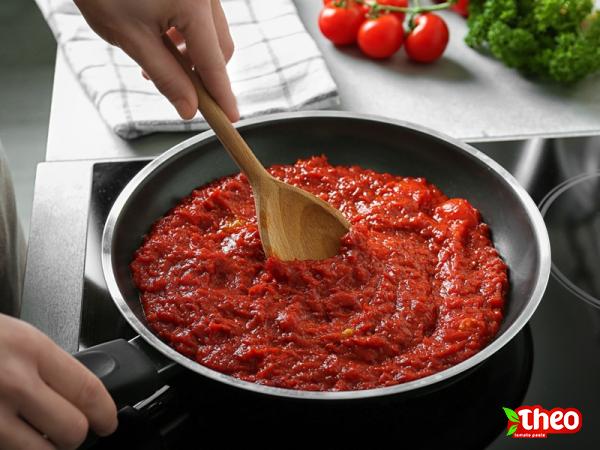A Comprehensive Guide to Paste Tomato Varieties Tomatoes are one of the most popular and widely consumed fruits around the world. Among the various types of tomatoes, paste tomatoes hold a special place due to their distinct characteristics, especially their thick flesh and low moisture content. This summary aims to provide a comprehensive guide to paste tomato varieties, highlighting their features, uses, and popular cultivars. Paste tomatoes, also known as sauce tomatoes, are best known for their high concentration of solids and low water content, making them perfect for cooking down into sauces, soups, and pastes. In addition to their culinary applications, their firm and meaty texture also earns them a spot in salads, sandwiches, and salsas. The key attributes of paste tomatoes are their thick walls, few seeds, and a dense, meaty interior. There are numerous varieties of paste tomatoes, each with their own unique characteristics. Some of the most popular ones include the San Marzano, Roma, Amish Paste, Opalka, and Plum Regal. Let’s explore these varieties in more detail: 1. San Marzano: Hailing from the San Marzano region in Italy, this variety is often regarded as the holy grail of paste tomatoes. Known for its sweet flavor, low acidity, and thick walls, San Marzano is ideal for making rich and flavorful pasta sauces. 2. Roma: Roma tomatoes are widely available and have become a standard choice for paste tomatoes. They have an elongated shape, meaty texture, and few seeds, making them perfect for canning, making tomato puree, or slow-cooking. 3. Amish Paste: As the name suggests, this heirloom variety originates from the Amish community. It offers a robust, tangy flavor with a balanced sweetness, making it a versatile option for various culinary uses. Amish Paste tomatoes are ideal for making salsas, sauces, and salsa frescas. 4. Opalka: Opalka tomatoes are large and slender, often reaching up to 6 inches in length. With a rich, sweet flavor and a low seed content, they are highly prized for making tomato paste, purée, and salsa. 5. Plum Regal: Plum Regal tomatoes are known for their uniform shape, deep red color, and meaty texture. They have a rich, complex flavor with undertones of sweetness, making them highly suitable for sauces, salsas, and ketchup.

tomato paste
 When choosing paste tomato varieties for planting or cooking, it is essential to consider factors such as disease resistance, fruit size, crop yield, and flavor profile. Additionally, determining whether to choose hybrid or heirloom varieties is a personal preference, with hybrid varieties often offering disease resistance and higher yields, while heirlooms provide unique flavors and historical significance. When it comes to growing paste tomatoes, they generally require similar cultivation practices as other tomato varieties. They thrive in warm, sunny climates and require well-drained soil. Most varieties benefit from staking or trellising to support the heavy fruit clusters and prevent diseases caused by contact with the soil. Adequate spacing is also crucial to promote good airflow and reduce the risk of fungal diseases. In terms of pest and disease management, paste tomatoes are susceptible to similar issues as other tomato varieties. Common pests include aphids, tomato hornworms, and whiteflies, while diseases like blight, blossom-end rot, and fusarium wilt can also pose a threat. Implementing preventive measures such as crop rotation, proper watering techniques, regular inspection, and prompt treatment can help mitigate these issues. In conclusion, paste tomatoes offer a distinct flavor, texture, and concentration of solids that make them ideal for culinary applications such as sauces, soups, and pastes. With their thick walls, low seed content, and robust flavors, paste tomato varieties like San Marzano, Roma, Amish Paste, Opalka, and Plum Regal are popular choices among home gardeners and professional chefs alike. By considering factors such as disease resistance, flavor profile, and growing conditions, one can select the most suitable paste tomato variety for their needs, ensuring a delicious and fruitful harvest.Title: A Comprehensive Guide to Paste Tomato Varieties Introduction: Paste tomatoes are a popular choice for culinary enthusiasts and professional chefs due to their thick flesh, low moisture content, and robust flavors. In this comprehensive guide to paste tomato varieties, we will delve deeper into the characteristics of different cultivars, their uses in the culinary world, and the business opportunities they present.
When choosing paste tomato varieties for planting or cooking, it is essential to consider factors such as disease resistance, fruit size, crop yield, and flavor profile. Additionally, determining whether to choose hybrid or heirloom varieties is a personal preference, with hybrid varieties often offering disease resistance and higher yields, while heirlooms provide unique flavors and historical significance. When it comes to growing paste tomatoes, they generally require similar cultivation practices as other tomato varieties. They thrive in warm, sunny climates and require well-drained soil. Most varieties benefit from staking or trellising to support the heavy fruit clusters and prevent diseases caused by contact with the soil. Adequate spacing is also crucial to promote good airflow and reduce the risk of fungal diseases. In terms of pest and disease management, paste tomatoes are susceptible to similar issues as other tomato varieties. Common pests include aphids, tomato hornworms, and whiteflies, while diseases like blight, blossom-end rot, and fusarium wilt can also pose a threat. Implementing preventive measures such as crop rotation, proper watering techniques, regular inspection, and prompt treatment can help mitigate these issues. In conclusion, paste tomatoes offer a distinct flavor, texture, and concentration of solids that make them ideal for culinary applications such as sauces, soups, and pastes. With their thick walls, low seed content, and robust flavors, paste tomato varieties like San Marzano, Roma, Amish Paste, Opalka, and Plum Regal are popular choices among home gardeners and professional chefs alike. By considering factors such as disease resistance, flavor profile, and growing conditions, one can select the most suitable paste tomato variety for their needs, ensuring a delicious and fruitful harvest.Title: A Comprehensive Guide to Paste Tomato Varieties Introduction: Paste tomatoes are a popular choice for culinary enthusiasts and professional chefs due to their thick flesh, low moisture content, and robust flavors. In this comprehensive guide to paste tomato varieties, we will delve deeper into the characteristics of different cultivars, their uses in the culinary world, and the business opportunities they present.
Specifications of tomato paste
 1. The Growing Demand for Paste Tomatoes: As the demand for fresh and locally sourced ingredients continues to rise, there is an increasing interest in paste tomatoes. These tomatoes are sought after for their rich flavor and versatility. With consumers seeking to incorporate authentic, homemade flavors into their dishes, the demand for quality paste tomatoes presents a significant business opportunity for farmers, gardeners, and food entrepreneurs. 2. Market Potential for Paste Tomato Varieties: The market potential for paste tomato varieties is vast and varied. From direct-to-consumer sales at farmers’ markets and roadside stands to supplying restaurants, grocery stores, and food processors, there are numerous avenues for businesses to capitalize on the popularity of paste tomatoes. Local food movements, farm-to-table restaurants, and the popularity of homemade sauces and condiments further contribute to the growing market potential. 3. Cultivating Paste Tomato Varieties: Cultivating paste tomato varieties requires careful consideration of factors such as climate, soil conditions, disease resistance, and market demand. Farmers and gardeners can benefit from conducting market research to identify the most sought-after varieties in their region. Additionally, selecting disease-resistant cultivars can reduce crop losses and increase yield, ensuring a profitable harvest. 4. Selecting the Right Paste Tomato Variety: Choosing the right paste tomato variety depends on several factors, including flavor preference, intended culinary use, and disease resistance. While popular cultivars like San Marzano and Roma are widely used, gardeners and farmers can experiment with lesser-known varieties to offer unique flavors and differentiate themselves in the market. Considerations such as fruit size, yield, and growth habit should also be taken into account when selecting varieties. 5. Cultivating Paste Tomatoes on a Commercial Scale: Cultivating paste tomatoes on a commercial scale requires careful planning and efficient production practices. Farmers should consider factors such as crop rotation, irrigation methods, pest and disease management, and post-harvest handling techniques. Maximizing yield, ensuring quality, and meeting market demands are crucial for the success of commercial paste tomato operations. 6. Establishing Relationships with Buyers: Building strong relationships with buyers is essential for businesses in the paste tomato industry. Direct sales to consumers, restaurants, grocery stores, and food processors can be facilitated through farmers’ markets, online platforms, or establishing direct partnerships. Maintaining consistent quality, timely delivery, and open communication with buyers can help cultivate long-term relationships and ensure a steady market for paste tomatoes.
1. The Growing Demand for Paste Tomatoes: As the demand for fresh and locally sourced ingredients continues to rise, there is an increasing interest in paste tomatoes. These tomatoes are sought after for their rich flavor and versatility. With consumers seeking to incorporate authentic, homemade flavors into their dishes, the demand for quality paste tomatoes presents a significant business opportunity for farmers, gardeners, and food entrepreneurs. 2. Market Potential for Paste Tomato Varieties: The market potential for paste tomato varieties is vast and varied. From direct-to-consumer sales at farmers’ markets and roadside stands to supplying restaurants, grocery stores, and food processors, there are numerous avenues for businesses to capitalize on the popularity of paste tomatoes. Local food movements, farm-to-table restaurants, and the popularity of homemade sauces and condiments further contribute to the growing market potential. 3. Cultivating Paste Tomato Varieties: Cultivating paste tomato varieties requires careful consideration of factors such as climate, soil conditions, disease resistance, and market demand. Farmers and gardeners can benefit from conducting market research to identify the most sought-after varieties in their region. Additionally, selecting disease-resistant cultivars can reduce crop losses and increase yield, ensuring a profitable harvest. 4. Selecting the Right Paste Tomato Variety: Choosing the right paste tomato variety depends on several factors, including flavor preference, intended culinary use, and disease resistance. While popular cultivars like San Marzano and Roma are widely used, gardeners and farmers can experiment with lesser-known varieties to offer unique flavors and differentiate themselves in the market. Considerations such as fruit size, yield, and growth habit should also be taken into account when selecting varieties. 5. Cultivating Paste Tomatoes on a Commercial Scale: Cultivating paste tomatoes on a commercial scale requires careful planning and efficient production practices. Farmers should consider factors such as crop rotation, irrigation methods, pest and disease management, and post-harvest handling techniques. Maximizing yield, ensuring quality, and meeting market demands are crucial for the success of commercial paste tomato operations. 6. Establishing Relationships with Buyers: Building strong relationships with buyers is essential for businesses in the paste tomato industry. Direct sales to consumers, restaurants, grocery stores, and food processors can be facilitated through farmers’ markets, online platforms, or establishing direct partnerships. Maintaining consistent quality, timely delivery, and open communication with buyers can help cultivate long-term relationships and ensure a steady market for paste tomatoes.
buy tomato paste
 7. Value-Added Opportunities: Along with fresh tomato sales, there are several value-added opportunities within the paste tomato market. Entrepreneurs can explore options such as producing tomato sauces, salsas, ketchups, and canned products for retail and wholesale distribution. Offering these value-added products can help increase revenue streams and capture a larger share of the market. 8. Collaborating with Restaurants and Chefs: Collaborating with restaurants and chefs can be a mutually beneficial partnership for both farmers and food establishments. By providing high-quality, locally grown paste tomatoes, farmers can cater to the demand for fresh, seasonal produce while increasing their brand visibility. On the other hand, restaurants and chefs can showcase the flavors of paste tomatoes in their signature dishes and promote the partnership. 9. Promoting Paste Tomato Varieties: Effective marketing and promotion are crucial to stand out in the competitive paste tomato market. Utilize social media platforms, websites, and local events to showcase the unique qualities of different paste tomato varieties. Engage with customers by sharing recipes, cooking tips, and the flavor profiles of various cultivars. This not only creates brand awareness but also educates consumers about the diverse range of paste tomato choices available. 10. Farm-to-Table Movement and Paste Tomatoes: The farm-to-table movement has gained significant traction in recent years, with consumers seeking out fresh, locally sourced ingredients. The distinct flavors and culinary versatility of paste tomatoes make them an ideal choice for farm-to-table restaurants and farmers looking to supply the demand for quality ingredients. Capitalize on this trend by marketing your paste tomato varieties directly to farm-to-table establishments. Conclusion: Paste tomato varieties offer a unique and sought-after culinary experience. From traditional favorites like San Marzano and Roma to lesser-known varieties that offer distinctive flavors, there is immense market potential for businesses involved in paste tomato cultivation, production, and distribution. By understanding the characteristics of different varieties, cultivating them efficiently, and establishing strong relationships with buyers, entrepreneurs can tap into this lucrative market and deliver the rich flavors of paste tomatoes to consumers’ tables.
7. Value-Added Opportunities: Along with fresh tomato sales, there are several value-added opportunities within the paste tomato market. Entrepreneurs can explore options such as producing tomato sauces, salsas, ketchups, and canned products for retail and wholesale distribution. Offering these value-added products can help increase revenue streams and capture a larger share of the market. 8. Collaborating with Restaurants and Chefs: Collaborating with restaurants and chefs can be a mutually beneficial partnership for both farmers and food establishments. By providing high-quality, locally grown paste tomatoes, farmers can cater to the demand for fresh, seasonal produce while increasing their brand visibility. On the other hand, restaurants and chefs can showcase the flavors of paste tomatoes in their signature dishes and promote the partnership. 9. Promoting Paste Tomato Varieties: Effective marketing and promotion are crucial to stand out in the competitive paste tomato market. Utilize social media platforms, websites, and local events to showcase the unique qualities of different paste tomato varieties. Engage with customers by sharing recipes, cooking tips, and the flavor profiles of various cultivars. This not only creates brand awareness but also educates consumers about the diverse range of paste tomato choices available. 10. Farm-to-Table Movement and Paste Tomatoes: The farm-to-table movement has gained significant traction in recent years, with consumers seeking out fresh, locally sourced ingredients. The distinct flavors and culinary versatility of paste tomatoes make them an ideal choice for farm-to-table restaurants and farmers looking to supply the demand for quality ingredients. Capitalize on this trend by marketing your paste tomato varieties directly to farm-to-table establishments. Conclusion: Paste tomato varieties offer a unique and sought-after culinary experience. From traditional favorites like San Marzano and Roma to lesser-known varieties that offer distinctive flavors, there is immense market potential for businesses involved in paste tomato cultivation, production, and distribution. By understanding the characteristics of different varieties, cultivating them efficiently, and establishing strong relationships with buyers, entrepreneurs can tap into this lucrative market and deliver the rich flavors of paste tomatoes to consumers’ tables.




